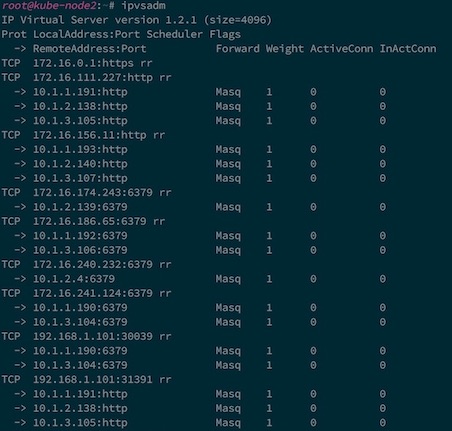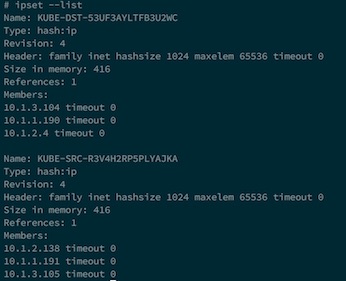Theory of Operation
Kube-router can be run as an agent or a Pod (via DaemonSet) on each node and leverages standard Linux technologies iptables, ipvs/lvs, ipset, iproute2
Service Proxy And Load Balancing
Blog: Kubernetes network services proxy with IPVS/LVS
Kube-router uses IPVS/LVS technology built in Linux to provide L4 load balancing. Each ClusterIP, NodePort, and LoadBalancer Kubernetes Service type is configured as an IPVS virtual service. Each Service Endpoint is configured as real server to the virtual service. The standard ipvsadm tool can be used to verify the configuration and monitor the active connections.
Below is example set of Services on Kubernetes:

and the Endpoints for the Services:

and how they got mapped to the IPVS by kube-router:

Kube-router watches the Kubernetes API server to get updates on the Services/Endpoints and automatically syncs the IPVS configuration to reflect the desired state of Services. Kube-router uses IPVS masquerading mode and uses round robin scheduling currently. Source pod IP is preserved so that appropriate network policies can be applied.
Pod Ingress Firewall
Blog: Enforcing Kubernetes network policies with iptables
Kube-router provides an implementation of Kubernetes Network Policies through the use of iptables, ipset and conntrack. All the Pods in a Namespace with 'DefaultDeny' ingress isolation policy has ingress blocked. Only traffic that matches whitelist rules specified in the network policies are permitted to reach those Pods. The following set of iptables rules and chains in the 'filter' table are used to achieve the Network Policies semantics.
Each Pod running on the Node which needs ingress blocked by default is matched in FORWARD and OUTPUT chains of the fliter table and are sent to a pod specific firewall chain. Below rules are added to match various cases
- Traffic getting switched between the Pods on the same Node through the local bridge
- Traffic getting routed between the Pods on different Nodes
- Traffic originating from a Pod and going through the Service proxy and getting routed to a Pod on the same Node

Each Pod specific firewall chain has default rule to block the traffic. Rules are added to jump traffic to the Network Policy specific policy chains. Rules cover only policies that apply to the destination pod ip. A rule is added to accept the the established traffic to permit the return traffic.

Each policy chain has rules expressed through source and destination ipsets. Set of pods matching ingress rule in network policy spec forms a source Pod ip ipset. set of Pods matching pod selector (for destination Pods) in the Network Policy forms destination Pod ip ipset.

Finally ipsets are created that are used in forming the rules in the Network Policy specific chain

Kube-router at runtime watches Kubernetes API server for changes in the namespace, network policy and pods and dynamically updates iptables and ipset configuration to reflect desired state of ingress firewall for the the pods.
Pod Networking
Blog: Kubernetes pod networking and beyond with BGP
Kube-router is expected to run on each Node. The subnet of the Node is obtained from the CNI configuration file on the Node or through the Node.PodCidr. Each kube-router instance on the Node acts as a BGP router and advertises the Pod CIDR assigned to the Node. Each Node peers with rest of the Nodes in the cluster forming full mesh. Learned routes about the Pod CIDR from the other Nodes (BGP peers) are injected into local Node routing table. On the data path, inter Node Pod-to-Pod communication is done by the routing stack on the Node.